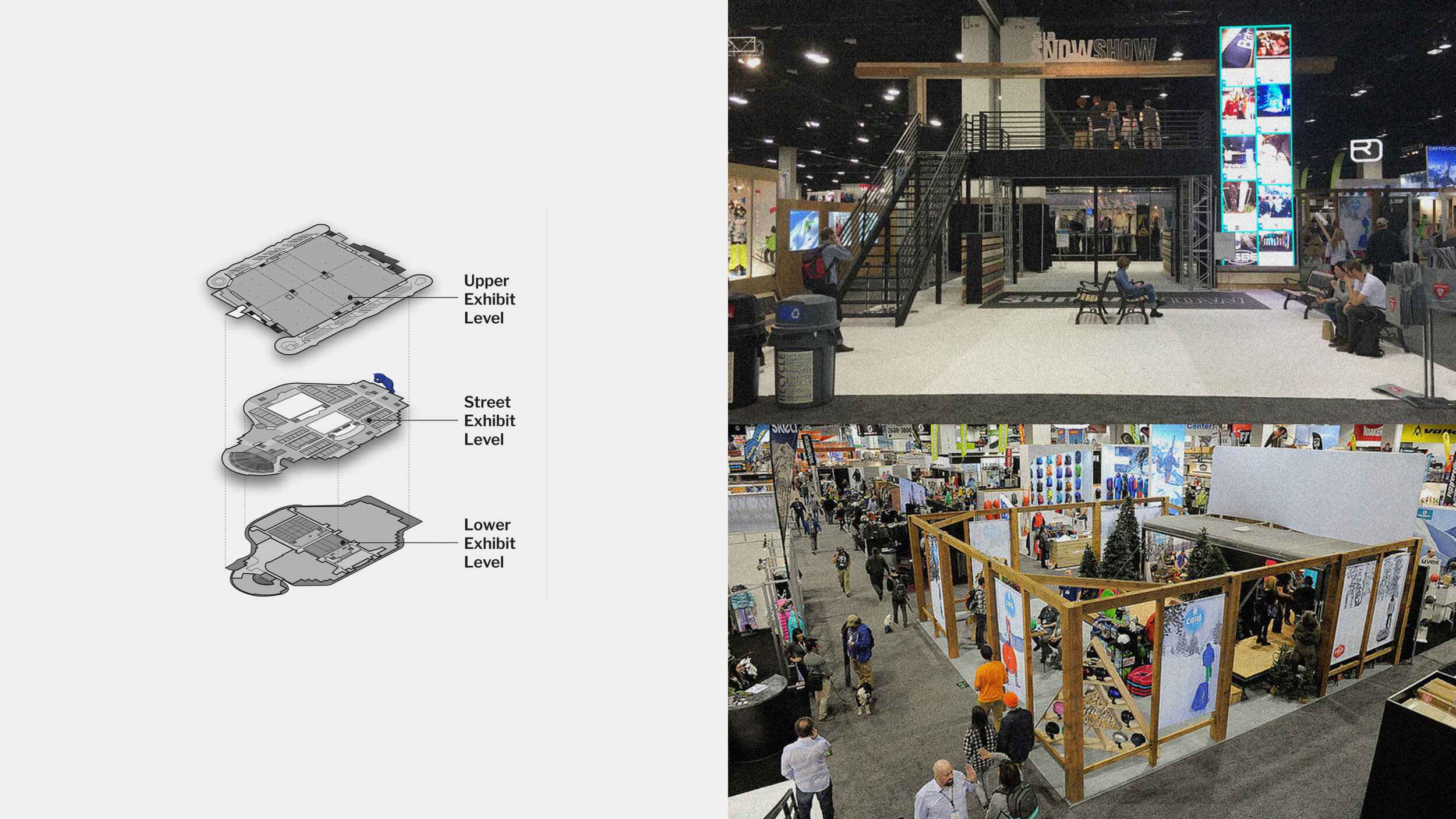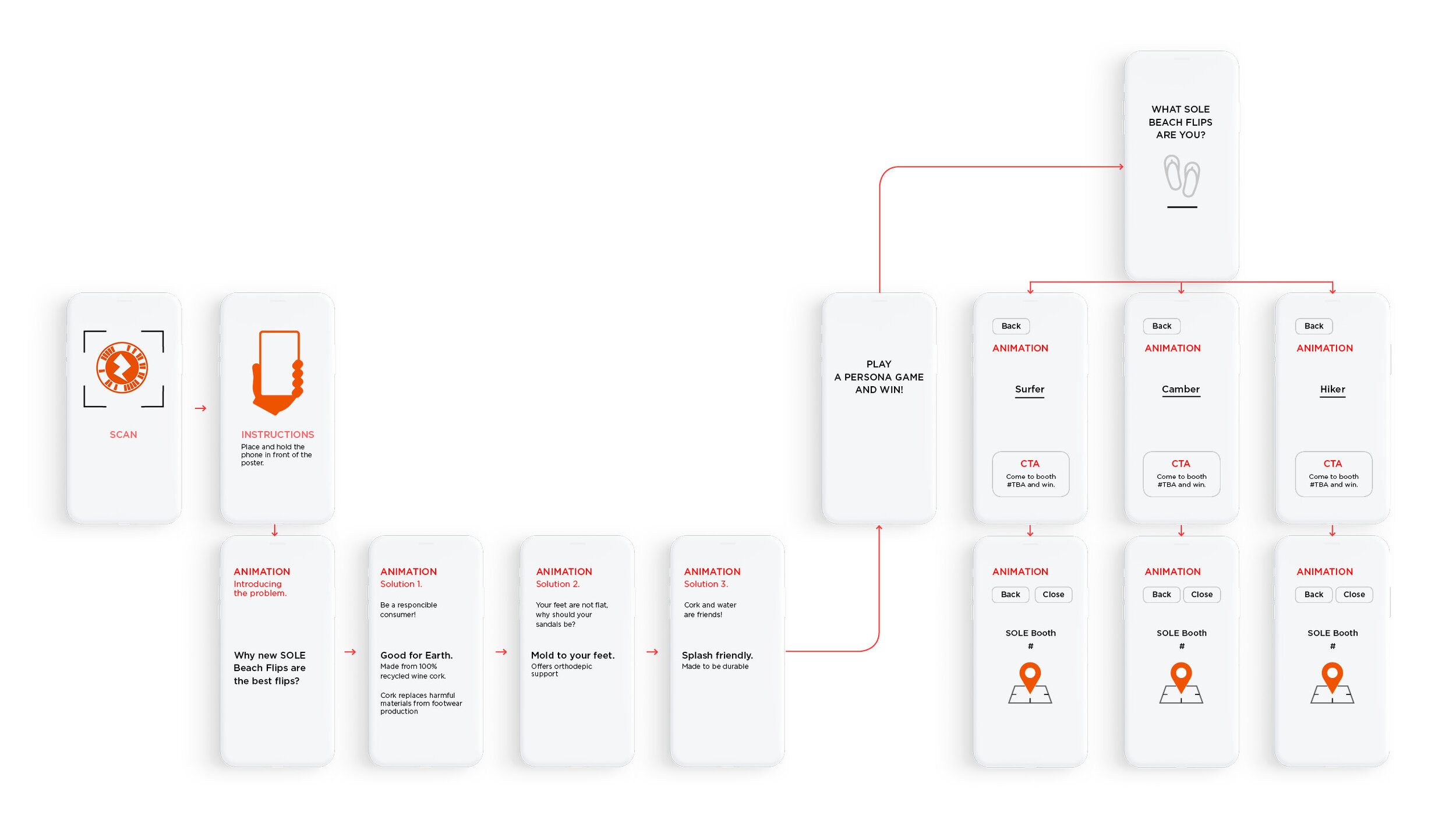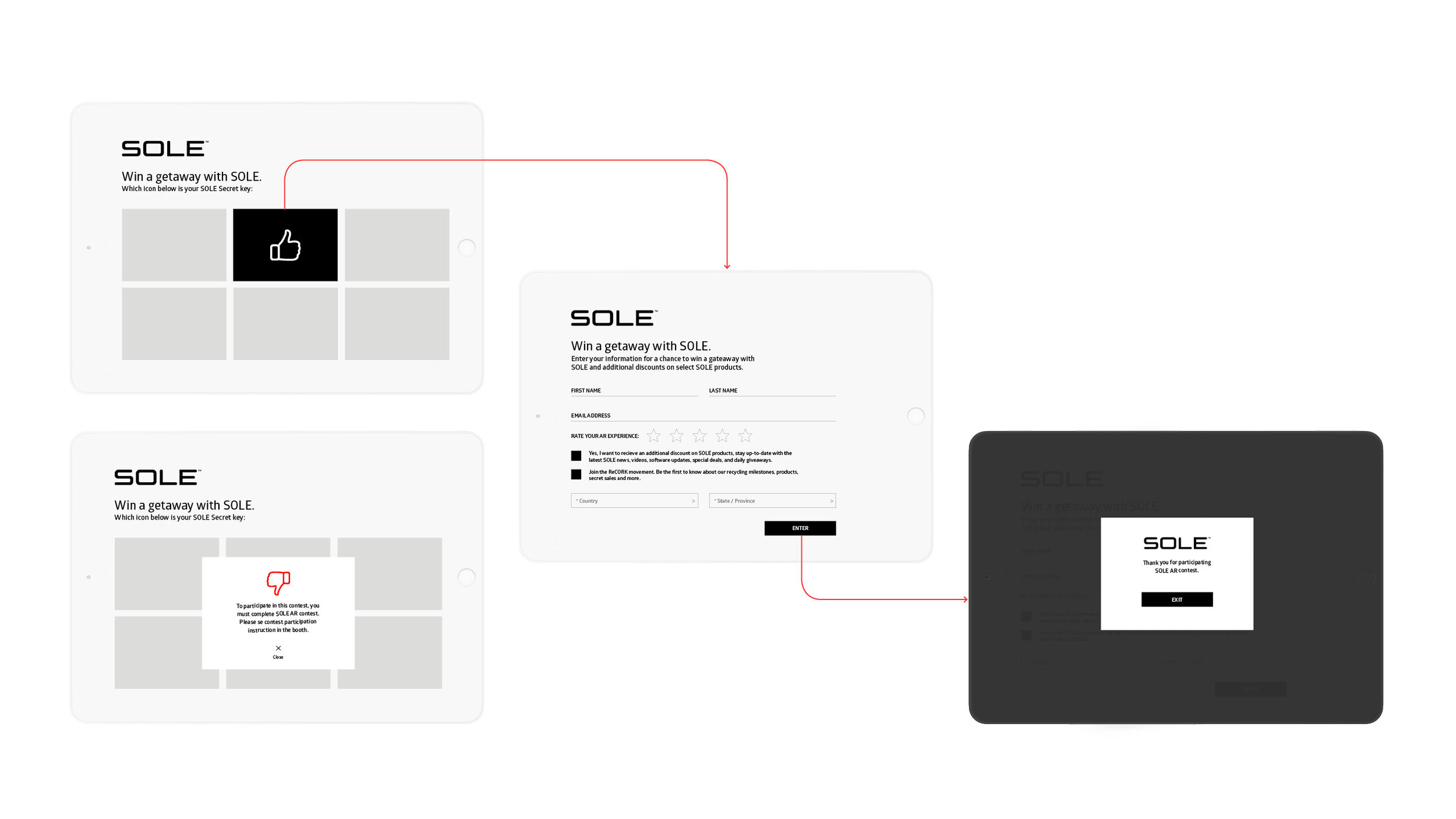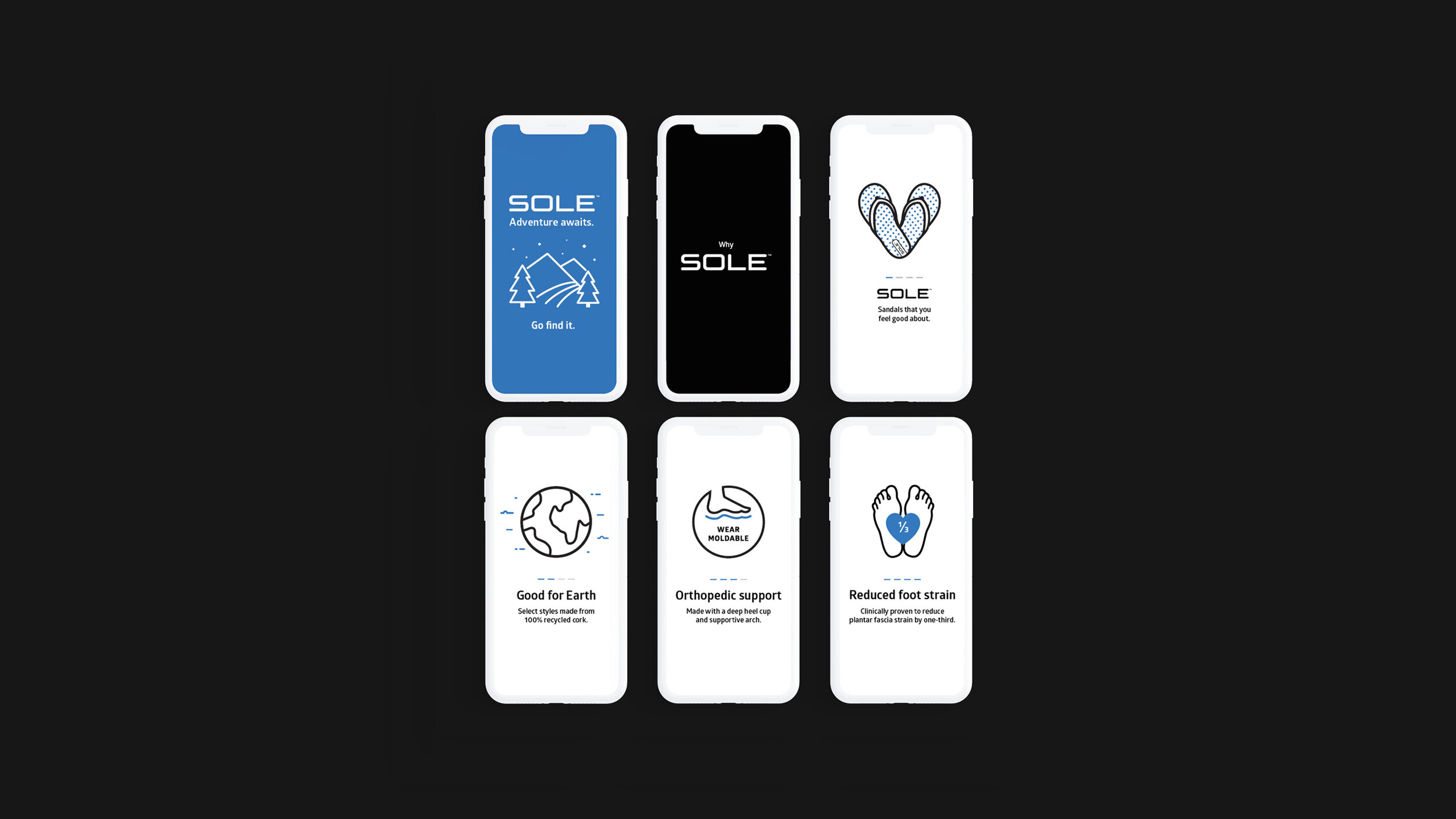UX/UI Case Study
AR Contest
Outdoor Retailer is the largest outdoor retail industry trade show in the US. This show is where brands can reach a larger, more diverse, and valuable retail audience via face-to-face interactions with brand ambassadors and buyers. Each brand brings its own branding an enhanced media presence and show-specific marketing to make itself stand out and carry its story into the consumer marketplace.
Together with a SOLE’s senior UX designer and ex-coworker, I helped to enhance the brand’s experience and tell its story in a new way in a highly competitive environment.
After conducting some research surrounding the possibilities and potential of augmented reality (AR) technology, we suggested that SOLE tests this new type of media experience at Outdoor Retailer. Considering the fact that the smartphone is the foundation for AR experiences and consumer engagement, we wanted to explore how the brand could engage trade show attendees with SOLE's story, values, and products while adding them to the company customer database.
Technology
Augmented Reality
Tools
ZapWorks, Adobe suite
Platform
Mobile, tablet

The challenge
As a medium-scale brand, SOLE is challenged to compete in the same highly competitive space as large, industry-leading brands. To do this, SOLE has purchased the rights to be the only brand at Outdoor Retailer allowed to post marketing materials in every bathroom at the trade show. This perhaps unconventional tactic has proved very effective over the last ten years at engaging an attentive audience.
In addition to bathroom guerrilla marketing, SOLE also hosts daily raffle draws at their trade show booth with large prizes to be won. To be entered to win, participants write their names on a paper slip and drop it into a branded box. This has proved to be a great way to stop passersby and engage them with the brand in a low-cost way. Each trade show presents new opportunities to find exciting and low-cost ways to engage potential buyers and customers.
High level goals
To create trade show booth drivers that engage diverse audiences and engage potential buyers in a crowded and competitive environment.
Retaining subscriber information and translating it to digital marketing campaigns.
Process
Research
Ideate & sketch
Design & prototype
Evaluate
Launch
Extract insights
Research
The Augmented reality industry is the next phase of computing which is already revolutionizing everyday experiences to a whole new, and completely unexpected, level. AR promises to enhance the way we live, work, play, socialize and shop. Consumers now switch between the real and digital worlds constantly and expect brands to cater for this.
AR is a powerful tool to achieve this, it lets businesses communicate at key moments drawing consumers in by offering value rather than pushing out content indiscriminately.
Of all the categories entrepreneurs are investing in, AR applications for commercial and industrial uses are right at the very top. There is enormous potential of AR in mobile apps to advance and increase productivity and profitability across various industries.
The use of an AR app for a business is not limited to logistics or training.
An AR app can:
Increase customer engagement and accessibility
Build brand recognition
Be another channel of company profitability
Provide support
Receive consumer feedback

This includes building deeper messages via AR in all in-store signage, having AR hosts that direct consumers to specific departments within a store, co-branded augmented products with shelf-talker callouts and instant coupon delivery based on AR actuation.
AR solutions are not out-of-reach solutions in the retail space, they are real and consumers love them. The more users feel connected with the product in AR, the easier it is for them to purchase items and share fun content with friends and family online.
69% of customers expect to have access to AR apps from the stores they love to shop at over the next six months. The more users feel connected with the product in AR, the easier it is for them to purchase items and share fun content with friends and family online.

Here is an example of great AR storytelling that inspired me during my working process:
Insights
Two of the most important questions we asked ourselves were:
How can new users be motivated to download, install, and engage with an AR app?
What value does the AR experience offer customers?
Ideation
We need to offer something valuable and desirable to inspire users to spend time downloading the app and engaging with AR content. I suggested that key details for a digital subscription for the contest will be presented exclusively through AR experience.
In the proposal for SOLE's first AR experience, we suggested the brand promote the story of their new sandal collection made with recycled cork. This project would educate trade show attendees about SOLE'e intention to reduce the amount of environmentally harmful materials used in their products and would serve as an effective and novel booth driver.
Solution
We developed and implemented an AR contest for the Summer 2018 Outdoor Retailer trade show, focusing on the flow and type of interactions customers would have with the technology across all touch points, from marketing materials to the digital signup form and post-experience survey.
Engagement
To motivate trade show attendees to engage with this new technology, we recommended that SOLE offer attractive product and incentive prizes which were heavily marketed with posters featuring a clear call to action.
Education
To explain to consumers how simple the AR setup experience is, we broke down the process into four steps:
1. Download the app.
2. Scan the code on the poster.
3. Use the app to learn about SOLE.
4. Visit the SOLE booth to enter and win!
Storytelling
The main AR experience was offered in the third step above. Once the user activated the Zappar code on the poster, we presented an animated story telling the story of how SOLE replaces environmentally harmful materials in their products with recycled cork. We set out to create a feeling of positive change and activism that comes with wearing SOLE products. We also took this opportunity to show SOLE's new product collections and inspire them to visit the SOLE trade show booth.
Strategy
To bridge the AR storytelling experience and the SOLE contest, we asked users to visit the SOLE trade show booth and answer a question related to the AR story they viewed before they could enter the contest. The contest was marketed with guerrilla stickers, posters, SOLE's social media, and marketing postcards place around the trade show.
Below is a visualized process of a series of actions a user goes through in order to accomplish a goal.

Design & prototype
Prototyping helped us to think through interaction models and new possibilities.
Prototype #1
The initial idea was to promote SOLE's new sandal collection through three simple steps. The first would introduce three facts explaining the benefits of SOLE sandals. The second asked users to play a game, exploring different buyer personas that represent the product collection: surfer, camper, and cyclist. The third step redirected users to the SOLE trade show booth to enter the contest.
Low-fidelity prototypes
I started working on the prototype, validating content flow on each screen.

Interactions
To make sure the user engaged with AR content, we came up with idea of Secret Key, a visual that would be shown at the end of AR experience, and would be asked to be selected during digital sign up in the booth.
Design
We simultaneously worked on the digital contest entry form and the feedback system for right or wrong activity.

Prototype #2
Based on feedback received from SOLE’s design team, we revised the initial idea and refined all points of interaction as follows:
Storyline development
I refined the storyline to appeal more to users, moving away from promoting SOLE's buyer personas and instead focusing on the kinds of outdoor activities and landscapes where SOLE products may be used.

Content refinement
We refined the content, providing very clear instructions regarding the contest date and how to navigate the trade show to get to the SOLE booth.
Visuals & flow
I designed and animated the content for the AR experience visuals and flow.
CTA
Refining product presentation screens and developing the call to action.
Prototype #3
I spent more time on the user interface, styling all visual elements of the AR story including buttons, icons, photos, and video files.

Interaction
Our goal was to ensure that we struck the right balance between content and the duration of interaction with the presentation. The written copy included in the presentation was minimal with easy-to-digest bullet points and more complicated concepts explained with animated icons.

Timing
Timing was a key focus in testing the AR storytelling experience. Questions we asked ourselves included, "How much content should be offered?" and, "How can I tell a brand story in a short timeframe while keeping users engaged?"
Execution
Before investing in the development of a native AR app, we validated the idea of the AR experience using ZapWorks tools. Zappar offers feature-full solutions with a free month’s trial and a flexible financial plan. It’s reliable and approachable and features the ability to track and review users’ interaction with an app.

Evaluation
We tested the app on different mobile devices, making sure the content
was visible and readable on the smallest screen and resizes nicely on bigger
screens, like the iPad’s.
Secret Key image on mobile screen and digital sign up form.

Launch
The tabloid-sized marketing posters were installed in all Outdoor Retailer trade show bathrooms, across three floors of a large exhibition building. Inside the SOLE trade show booth, access to the AR experience and contest entry was provided through a tablet installed with the Zappar App.
1. A trade show attendee is scanning the Zappar Code.
2. She follows though all the screens.
3. She decides to participate in the contest by signing up!
Conclusion
Based on Zappar statistics, the Zapcode was activated 22 times and 15 users completed the AR presentation and entered the contest. While we entered into this project without any expectations that trade show attendees would interact with the AR presentation, these numbers fell short of where we would have liked to see them. The reasons for low engagement could have included:
A novelty effect
As Lindsay Boyajian from Network World states in a recent article, “ One of the most difficult challenges about AR is educating the broader market. Consumers aren’t exposed to AR regularly and don’t see its wide-reaching applications in their daily lives. However, there are plenty of AR experiences available today that just lack exposure in the consumer market.”
Time restrictions
Time requirements, immediacy & tech restrictions: Installing the AR app on a mobile device takes time and a certain level of commitment from the user. Considering that trade show attendees are business oriented and often under time constraints, asking for even five minutes of attention is a huge obstacle to overcome. A tech solution that would eliminate the installation requirement and allow immediate access to content would likely boost user engagement in the same setting.
Value
It is possible that the audience we were attempting to reach were not interested in the prizes offered for the contest.

There isn’t a mass adoption of AR just yet, but it is growing.
According to various surveys and the latest revenue forecasts, it seems that AR is set to be three times as profitable as virtual reality (VR) is, especially for enterprise users. Companies are realizing the sheer magnitude of potential in AR application investments and are looking for ways to capitalize on them. Based on Global AR and VR revenue forecasts from December 2017, AR enterprises will grow from $4 billion to $80 billion by the year 2021.
I believe it is beneficial to continue to experiment with AR because we are moving towards a reality of mixed digital and real spaces and businesses are readying themselves today to avoid being left behind. I am excited to observe Extended Reality developments and keep researching potential applications for AR and finding better ways to engage with audiences with high-value content.
Thank you for your time!





